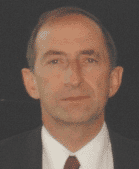
Flight Science & Technology Research Group
The Wright Brothers Project
Department Home
Page
Courses
Simulation
Facilities
Feedback: mdw@liv.ac.uk
The Engineers
Ben Lawrence received his BEng (Hons) degree in Aerospace Engineering (2000) from the University of Liverpool, UK. Following that he became one of the founder members of the Flight Science and Technology research group in the University of Liverpoolís Department of Engineering. He is currently studying for his Ph.D focusing on the Flight Handling Qualities of the early Wright Brothersí aircraft. Benís research interests are oriented around simulation and flight dynamics and he is a key contributor in a number of simulation projects being conducted at the University of Liverpoolís Bibby Flight Simulation Laboratory. In 2003 Ben Lawrence won the the 2003 SFTE international symposium best paper award and was awarded a Royal Aeronautical Society Centennial Scholarship.
Gareth Padfield received a BSc(Hons) degree in Aeronautical Engineering at the University of London in 1969 and Ph.D in Flight Dynamics at Cranfield in 1976. During the intervening years he worked at Westland Helicopters as a stability and control engineer. He joined the Royal Aircraft Establishment in 1977 and during his 23 year career at the RAE/DERA, he specialised in helicopter flight research; his final position in DERA was the Air Systems Rotorcraft Chief Scientist. Gareth Padfield took up the James Bibby Chair in Aerospace Engineering at The University of Liverpool in 1999, where he is Director of the Aerospace Engineering School and leads the Flight Science and Technology (FST) Research Group in the Department of Engineering. His research interests include flight handling qualities and control, modelling and simulation and flight dynamics.
gareth.padfield@liverpool.ac.uk
The Test Pilot
Roger Bailey started pilot training with the Royal Air Force in 1969, and later served with 48 Squadron, 24 Squadron, and 242 OCU as Co-pilot, Captain, and Training Captain respectively. He attended the Central Flying School in 1981 to train as a Qualified Flying Instructor and subsequently served on the Universities of Glasgow and Strathclyde Air Squadron. In 1986 he attended the United States Air Force Test Pilot School as an exchange student.
After graduating in December 1986 he joined Flight Systems Squadron at the Royal Aircraft Establishment, Bedford. He was appointed the Officer Commanding Aerospace Research Squadron in 1988 and retired from the Royal Air Force in December 1989. After leaving the RAF he joined the College of Aeronautics at Cranfield University as Chief Test Pilot, a post he holds to the present day. In 1989 he joined the volunteer pilot cadre of the Shuttleworth Collection, a museum of over thirty airworthy veteran aircraft. With the Shuttleworth Collection he has flown early aircraft including the Bristol Boxkite and Avro Triplane replicas and the Bleriot, Deperdussin and Blackburn original monoplanes.
The Flight Science and Technology Research Group's facilities are unique within a University environment and features a 6 degree of freedom full motion flight simulator. The simulator uses the comprehensive FLIGHTLAB simulation environment and is capable of simulating any aircraft including rotary wing, fixed wing, gliders and tilt rotors. Housed in a purpose-built research centre, the facility incorporates areas for pilot briefings and substantial computational support and provides unique opportunities to address questions relating to pilot-vehicle technologies. The facility introduced high fidelity simulation into academia for research and undergraduate/ graduate aerospace engineering programmes. The simulator is used in a variety of research projects including the Handling Qualities of the European civil Tilt Rotor Aircraft (RHILP & ACT-TILT), Simulation Fidelity Criteria, Visual Perception in Flight Control, Aircraft Pilot Couplings, Helicopter Interactions with Turbulent Wakes and historic aircraft: The Wright Brothers Project and the da Vinci glider. The current aircraft library has over 16 aircraft types, including fixed wing, rotary wing, tilt-rotor aircraft and gliders.



